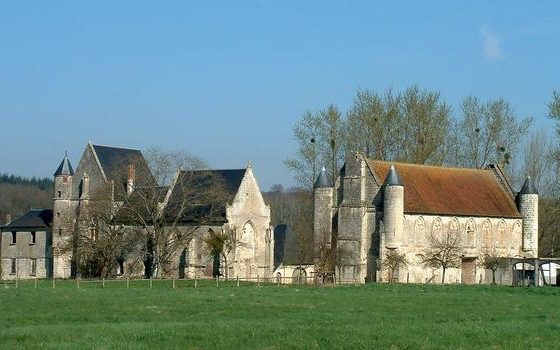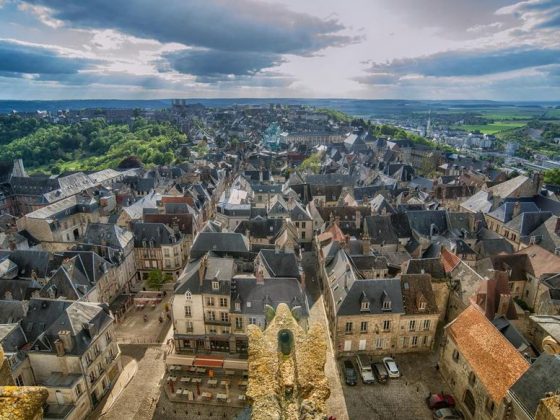VFF16 - From Tergnier to Laon
VFF16 - From Tergnier to Laon
Gps Track
- Total Length: 38,7 km
- Difficulty by Foot: Hard
During this stage, you will first pass through villages such as Beautor and then Deuillet. In the latter, the Calvary-Oratory is noteworthy. In Saint-Nicolas-aux-Bois, several ancient monuments will also hold your attention.
The former Benedictine abbey, founded around the year 1080, now integrated into a private property, has interesting remains: behind the wall, the abbey lodging building and the dungeon remain. The Tortoir is a fortified priory of the fourteenth century. The robust Cross Cesine stands as a sentry at the beginning of the village. In the village of Cessières, the Saint-Sulpice-et-Saint-Antoine church was fortunate enough not to have been destroyed by the war, unlike the churches of the neighboring villages. The village of Molinchart is distinguished less by its monuments than by its natural curiosity: a rocky chaos named the Gargantua’s Hottée. Your journey of the day ends up in Laon, the county capital city. This city is called “the crowned mount” due to its silhouette, visible from miles round. Its “ethereally” outlined cathedral, given the numerous openings of its towers, is remarkable. At the corner of a street is a chapel of the Knights Templar. Further on, there is the church with the Dutch name “Sint Martinus kerk”. The old episcopal palace is imposing, and the fortifications with its strange leaning tower also are so in their own way.
- VFF47 – From Pontarlier à Jougne historic route
- VFF47bis – Variant from Pontarlier to L’Auberson/Sainte Croix
- VFF46 – From Mouthier Haute Pierre to Pontarlier
- VFF45 – From Foucherans to Mouthier-Haute-Pierre
- VFF44 – From Besançon to Foucherans
- VFF43 – From Cussey sur l’Ognon to Besançon (Pont Battant)
- VFF42 – From Bucey les Gy to Cussey sur l’Ognon
- VFF41 – From Dampierre sur Salon to Bucey les Gy
- VFF40 – From Champlitte to Dampierre sur Salon
- VFF18 – From Corbeny to Berry Au Bac
- VFF17 – From Laon to Corbeny
- VFF15 – From Seraucourt Le Grand to Tergnier
- VFF14 – From Trefcon to Seraucourt Le Grand
- VFF13 – From Peronne to Trefcon
- VFF12 – From Bapaume to Peronne
- VFF11 – From Arras to Bapaume
- VFF10 – From Ablain Saint Nazaire to Arras
- VFF09 – From Bruay La Brussiere to Ablain Saint Nazaire
- VFF08 – From Amettes to Bruay La Brussiere
- VFF07 – From Thérouanne to Amettes
- VFF06 – From Wisques to Thérouanne
- VFF05 – From Tournehem-sur-la-Hem to Wisques
- VFF04 – From Licques to Tournehem-sur-la-Hem
- VFF03 – From Guines to Licques
- VFF02 – From Wissant to Guines
- VFF01 – From Calais to Wissant
- VFF39 – From Coublanc to Champlitte
- VFF38 – From Culmont-Chalindrey to Coublanc
- VFF37 – From Langres to Culmont-Chalindrey
- VFF36 – From Faverolles to Langres
- VFF35 – From Richebourg to Faverolles
- VFF34 – From Orges to Richebourg
- VFF33 – From Baroville to Orges
- VFF32 – From Dolancourt to Baroville
- VFF31 – From Dienville to Dolancourt
- VFF30 – From Précy-Saint-Martin to Dienville
- VFF29 – From Montmorency-Beaufort to Précy Saint Martin
- VFF28 – From Outine to Montmorency-Beaufort
- VFF27 – From Saint-Rémy-en-Bouzemont to Outines
- VFF26 – From Vitry-le-François to Saint-Rémy-en-Bouzemont
- VFF25 – From Saint-Amand sur Fion to Vitry le François
- VFF24 – From Saint-Germain la Ville to Saint-Amand sur Fion
- VFF23 – From Châlons en Champagne to St-Germain-la-Ville
- VFF22 – From Condé sur Marne to Châlons en Champagne
- VFF21 – From Verzy to Condé sur Marne
- VFF20 – From Reims to Verzy
- VFF19 – From Berry au Bac to Reims




